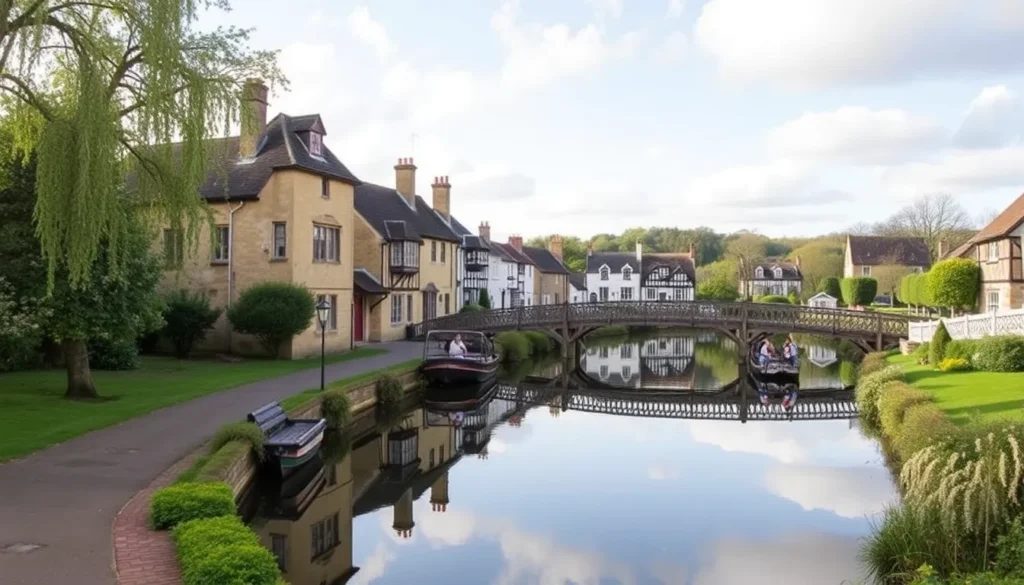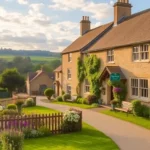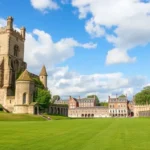10 Essential Things to See and Do in the Cotswolds

- Exploring the enchanting villages of the Cotswolds
- Visiting Sudeley Castle
- Exploring Blenheim Palace
- Discovering Minster Lovell Hall and Dove
- Exploring Lacock Abbey
- Visiting Stratford-upon-Avon, the birthplace of Shakespeare
- Exploring Bath
- Visiting Stonehenge
- Hiking the Cotswolds Way
- Enjoying the local gastronomy
- Extra: Enjoying a pint at a traditional pub
- More places to see in the Cotswolds
Are you planning a trip to the Cotswolds and wondering what the must-see places are? This article dives into the best sights and activities in the Cotswolds, ensuring you have a memorable escape through the enchanting English countryside.
Imagine picturesque villages built stone by stone, charming landscapes, lush green hills, winding roads, and cottages that look like they’ve stepped straight out of a Beatrix Potter tale. Welcome to the Cotswolds! Each mile here is savored like a fine wine, even if you find yourself sipping a pint of ale in one of the century-old pubs. Who knows, you might even end up sharing a table with Hugh Grant, Bridget Jones, or Harry Potter! 😉
So, where exactly are the Cotswolds located? This stunning area in the soutwest of England spans five counties: Gloucestershire, Oxfordshire, Warwickshire, Wiltshire, and Worcestershire. It is approximately 100 miles from London (about 150 km), making it a popular day trip for many visiting the capital. However, the best way to explore is to fly into Bristol Airport to rent a car and embark on a multi-day itinerary to truly immerse yourself in all its beauty.
⭐ Guide for renting a car and driving in the UK
Once you arrive, what awaits you? Picture the quintessential English countryside filled with green pastures dotted with cows and sheep, roads meandering through shady trees and babbling brooks untouched by droughts and storms. The area boasts limestone villages with slate roofs that seem frozen in time, alongside castles and medieval palaces, scenic hiking trails, and serene lakes. Ready to discover everything the Cotswolds have to offer? Let’s dive in!
Do you know where the name Cotswolds comes from? It is derived from the words COTS, referring to sheep shelters, and WOLDS, meaning gentle hills. Between the 13th and 15th centuries, this area gained fame for its wool trade.
Exploring the enchanting villages of the Cotswolds
The true treasure of the Cotswolds lies in its collection of small and picturesque villages that appear between rivers and hills. These humble, rural communities have now become sought-after destinations for those looking to enjoy their dream retirement, and it’s understandable why.
Once homes to workshops and sheep, the stone houses are now charming architectural gems that retain their traditional soul amidst a romantic, pastoral backdrop that captivates anyone who visits. If you have a few million pounds in the bank, even better!
During our 5-day exploration, we managed to visit many villages, but if you're short on time and want to focus on the most beautiful ones, consider these six:
- Bourton-on-the-Water: Known as the Venice of the Cotswolds for its lovely stream and stone bridges, though it’s not quite a comparison. Still, it’s truly beautiful.
- Bibury: The artist William Morris called it the most beautiful village in England. We won’t argue with that, especially when standing before Arlington Row, the most famous street in the Cotswolds.
- Castle Combe: Here lies one of the quintessential images of the Cotswolds: a medieval bridge surrounded by honey-colored houses.
- Lower Slaughter: Offers a charming walk to an old watermill, perfect for a leisurely afternoon.
- Snowhill: A tiny village centered around St. Barnabas Church, featuring its photogenic cemetery and the iconic red telephone booth. Fun fact: it’s the hometown of Bridget Jones's parents in the movie!
- Stow-on-the-Wold: Home to the peculiar St. Edward’s Church, where the entranceway is flanked by two tree trunks.
⭐ For more detailed information, check out our post on the prettiest villages in the Cotswolds.
Book your accommodation in the Cotswolds at the best prices here.
Visiting Sudeley Castle
At the heart of the English countryside lies Sudeley Castle, which is not only a stunning architectural marvel but also holds a unique distinction: it is the only private castle that houses the remains of an English queen, specifically Catherine Parr, the sixth wife of Henry VIII.
After the king's death, Catherine married Sir Thomas Seymour, who purchased the castle in 1542. Consequently, when Catherine passed away in 1548, she was buried within its walls. Over time, the castle fell into disrepair for 200 years until a powerful family acquired and restored it. While it remains a private residence, it is open to the public for visits (for a fee), along with its beautiful gardens, St. Mary’s Church, and the surrounding estate.
- Entry costs £19.50
Exploring Blenheim Palace
Another majestic destination in the Cotswolds is Blenheim Palace, the residence of the Dukes of Marlborough. Built in the early 18th century as a gift from Queen Anne to John Churchill (the Duke of Marlborough) in gratitude for his military achievements, the palace is famous for being the birthplace of Winston Churchill, a key figure in British history.
The objective was to create a Versailles in England: rooms adorned with opulent tapestries, portraits, and antique furnishings, a 55-meter-long library, and vast gardens. It’s no wonder that UNESCO declared it a World Heritage Site.
While the entry can be pricey, there’s a clever way to see the palace for free: park your car near the often-overlooked The Black Prince Pub, where you can find a public path leading to one of the palace's entrances. This way, you can enjoy the stunning facade without spending a penny. The path winds past ponds and features a tree that fans of Harry Potter will recognize from the film.
- Entry costs £35 (Palace + Gardens)
Discovering Minster Lovell Hall and Dove
We stumbled upon the ruins of an ancient 15th-century manor house almost by accident while browsing Google Maps, and it turned out to be one of the best discoveries of our trip to the Cotswolds. Located on the banks of the Windrush River, right next to a quaint church with its own charming cemetery, this site is delightful during the day but might be eerie at night.
What remains of the once splendid residence of the Lovell family includes a massive hall, the manor’s tower, and what was reportedly a dovecote, which is still in use today (watch out for droppings!). Scattered throughout the surviving walls, you'll find details like vaulted ceilings, arches, and decorated windows.
According to legend, Lord Lovell (Francis Lovell) drowned in the Windrush River, and his body was carried downstream to Minster Lovell Hall. Since then, it is said that his ghost wanders the ruins at night.
Therefore, it's best to visit in broad daylight, and it's also a great idea to bring a snack for an improvised picnic. There are no benches or tables, but you can sit on the ruins or under the trees, enjoying a meal amidst such an incredible setting. It was one of the highlights of our journey.
- Entry is free
Exploring Lacock Abbey
Just outside the small village of Lacock lies an ancient abbey with an 800-year history. Founded in 1232 by the esteemed Countess of Salisbury as a convent for Augustinian nuns, it later became a country residence, undergoing renovations and expansions that resulted in its current appearance.
Today, it is managed by the National Trust, which has opened its doors for visitors to explore various rooms and gardens. One section features the Fox Talbot Museum, dedicated to the life of its former resident who is credited with inventing the photographic negative. However, the abbey's crown jewel is its exquisite medieval cloister, which remains unchanged and has appeared in several films, including Harry Potter and the Sorcerer's Stone, Pride and Prejudice, and the series Downton Abbey.
- Entry costs £18.70
Visiting Stratford-upon-Avon, the birthplace of Shakespeare
Did you know that right next to the Cotswolds, you can visit the town where playwright William Shakespeare was born? This fact has put Stratford-upon-Avon on the map, and everything here revolves around this literary icon: the house where he was born, the one he bought later in life, and numerous statues and inscriptions in his honor.
Moreover, Stratford-upon-Avon is a delightful small town worth exploring in its own right, boasting a quaint historic center filled with buildings featuring traditional timber-framed facades characteristic of Tudor architecture. So, aside from soaking in the atmosphere celebrating England's most significant literary figure, you’ll enjoy a charming visit. And if you have time, consider taking a stroll along the River Avon.
Should you go or not? That is not the question, dear Hamlet of my heart… The answer is quite simple: you must go!
⭐ For more information, check out everything to see and do in Stratford-upon-Avon.
Exploring Bath
Another highly recommended excursion in the Cotswolds is a visit to the ancient spa city of Bath. A UNESCO World Heritage Site, it is brimming with Georgian architecture, quaint shops, significant festivals such as those celebrating Jane Austen or Glastonbury, and, of course, the Roman baths! Bath also boasts one of the most stunning Gothic-style abbeys in the country.
Founded by the Romans in 43 A.D., it was known as Aquae Sulis. After the fall of the Roman Empire, Bath fell into obscurity until the 18th century, when British aristocracy transformed it into a tourist destination. Most of the Georgian buildings you see today date from that period. Today, Bath is one of the most visited spots in England and a lively university town.
We spent a few hours here on our last day and wished we could have stayed overnight; we’re sure it has a vibrant atmosphere in the evenings. We enjoyed some meat pies at The Raven, which were quite tasty, and it's a cozy, central spot.
Remember to grab a Revolut card (with a €10 promo) to avoid fees when paying and withdrawing money abroad!
Visiting Stonehenge
How could we forget the famous site of Stonehenge? This megalithic monument, a UNESCO World Heritage Site, dates between 3100 B.C. and 2000 B.C. and is one of humanity's greatest mysteries. It consists basically of a circle of megalithic stones, and its purpose remains an enigma: some believe it was a religious sanctuary, while others suggest it served as an astronomical observatory.
Located about 13 km north of Salisbury, just south of the Cotswolds, it can be visited with an admission fee, or there’s a clever trick… There’s a free path that runs right alongside the official one and offers nearly the same views.
- Entry costs £26 (you can purchase in advance here)
- You can also visit on a day trip from London
⭐ We will soon publish a post detailing how to see Stonehenge for free.
Hiking the Cotswolds Way
Good news for hiking enthusiasts: this region is traversed by the Cotswolds Way, a 164 km (102 miles) long trail that passes through villages, beautiful natural landscapes, rolling hills, valleys, and historical sites (including the site of the Battle of Lansdowne, Hailes Abbey, and the Tyndale Monument). The trail starts in Bath and stretches to Chipping Campden, a medieval village where you can visit a quirky covered market.
From what we observed, the paths are well-marked, and many people embark on daily excursions, covering small sections of the Cotswolds Way. Important: wear proper walking shoes, bring a raincoat (the weather can change rapidly here), have water on hand, and if traveling during peak season, book accommodation and popular restaurants in advance. Check official website for more info.
If you’d prefer some shorter trails, here are a few highlights:
- Hike to the Broadway Tower from the village.
- Explore the forests around Crickley Hill.
- Ascend Leckhampton Hill.
- Stroll through the meadows surrounding Stanton.
Enjoying the local gastronomy
Indulging in scones, cheese, steaming lamb dishes, fish & chips (of course), Sunday roast, and meat pies is a must while in the Cotswolds. This region is renowned as one of England's foodie meccas. However, dining well in England typically requires a bit of a splurge; it’s not the cheapest unless you opt for something quick like fish & chips or burgers.
Here are some typical dishes and products to try in the Cotswolds:
- Cotswold Lamb: With so many sheep around, it makes sense. The local lamb stew or roast is famous for being tender and juicy, served with local vegetables and/or potatoes.
- Meat Pie: Typically made with spiced pork. Few dishes are as traditional as these “pies” (not to be confused with “pieces”).
- Cotswold Blue Cheese: While there are many types of cheese in the region, the blue cheese, with its mild and creamy flavor, is considered one of the best.
- Cotswold Plum Pudding: If you see this plum pudding on a restaurant or tearoom menu, don’t hesitate! It’s delicious, served warm with sauce or cream. Yummy!
- Scones: Nothing beats a freshly baked scone with butter and jam to accompany your English tea. Be warned, they are addictive! A great place to try them is Tisane Tea Room in Broadway.
- And of course, if you’re traveling on a Sunday, don’t miss the Sunday Roast! We enjoyed ours at The Crown & Trumpets Inn, and it was fantastic.
⭐ Check out this post where we recommend 8 places to eat well and affordably in the Cotswolds.
Extra: Enjoying a pint at a traditional pub
We wrap up our recommendations for things to see and do in the Cotswolds with a delightful traditionally served English ale. If you’re like us, every travel day feels even more enjoyable when celebrated with a beer. And being in England, we can't pass up the chance to step into a traditional pub and toast with a pint. You’ll find various options, from cold lagers or IPAs to warmer ales or stouts.
You can also opt for a cider, which is one of the most loved and famous drinks in the Cotswolds, so be sure to give it a try!
There are traditional pubs in every village, and interestingly, most of the best pubs in the Cotswolds are located within hotels and inns. The atmosphere is fantastic, and for us, it’s one of the best things to do in the Cotswolds.
More places to see in the Cotswolds
Of course, there are many more things to see and do in the Cotswolds, so if you have more time, here are some additional ideas:
- Go shopping: The antique shops we found in Cotswold villages, especially in Tetbury, left us with hearts in our eyes (and surprisingly better prices than we expected).
- The Westonbirt Arboretum, owned by the National Trust, is the most important botanical garden of its kind in England. It was designed by Robert Holford in 1829, a botany enthusiast who began collecting new and exotic species from around the world. Today, it hosts nearly 15,000 trees and shrubs, divided into several sections (the Chinese and Japanese gardens are particularly interesting). Entry costs £12-16.
- Founded by the Norman nobleman William FitzOsbern, Berkeley Castle has been the scene of numerous tumultuous events, the most famous being the murder of King Edward II. Who was the culprit? His wife, Queen Isabella, and her lover, Roger Mortimer, reportedly imprisoned him and left him to die of hunger and thirst.
- The Cotswold Water Park can be fun for a family trip to the Cotswolds in summer. It’s a complex of artificial lakes offering water sports like kayaking or windsurfing, boat rides, or simply a meal at a local restaurant with great views.
- If you visit the Cotswolds between June and late July, you can witness the lavender fields, one of the area’s most popular sights.
- Although the Roman sites in this area aren’t particularly impressive, the Chedworth Roman Villa (entry costs £12) stands out for its remarkably well-preserved mosaics.
- If you want to leave with a panoramic view of the English countryside, several hills feature great lookout points. Note these: Painswick Beacon, Crickley Hill, and Cleeve Hill, all offering excellent hiking options.
As you can see, in the Cotswolds, you can explore honey-colored stone villages that, in themselves, are worth the journey, but there’s so much more to see and explore in this bucolic region of England. Do you know more things to see and do in the Cotswolds?
| Save on your trip |
| Compare and find cheap flights here |
| Find accommodation at the best prices here |
| Book activities and excursions in Spanish here |
| Get a €10 gift by booking transport across Europe here |
| 5% off on your travel insurance with IATI here |
| Reserve airport transfers here |
| Find out how to withdraw money without fees here |
| Get a 5% discount on your eSIM from Holafly here |
| Rent a car with the best deals here |
| Compare prices on van rentals here |
| The best books and travel guides here |
| All our articles about England |





Deja una respuesta